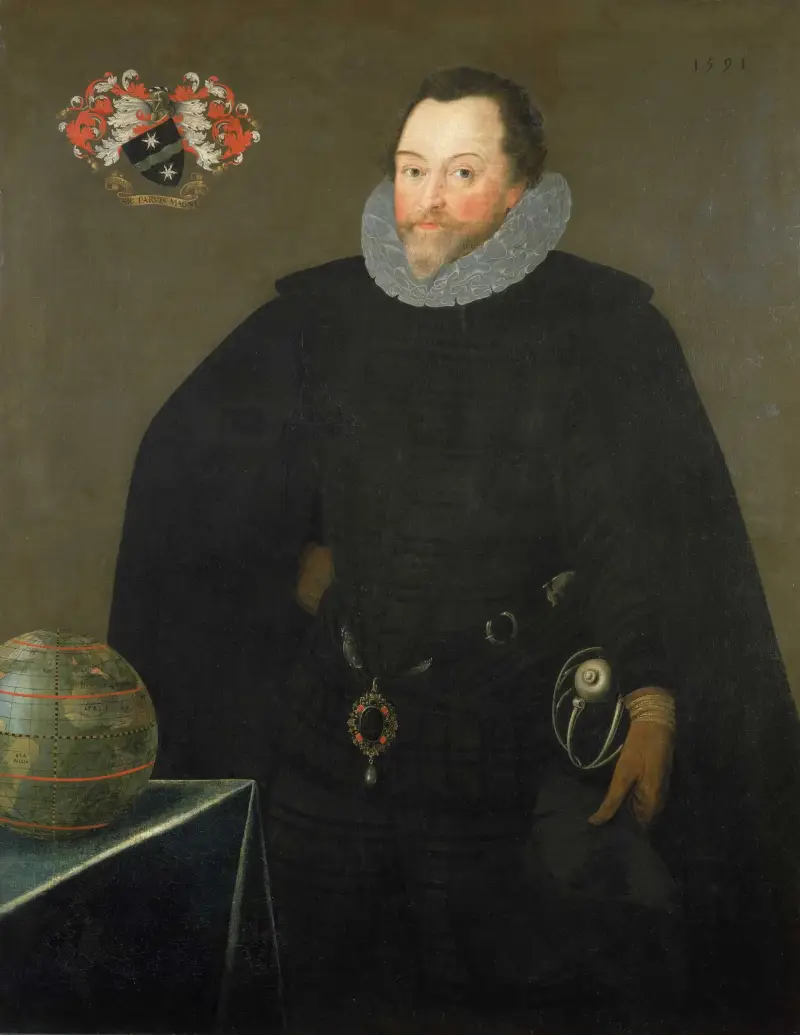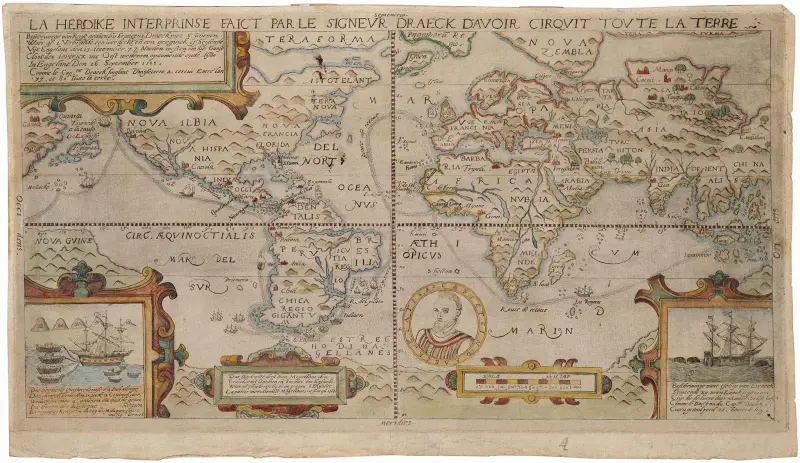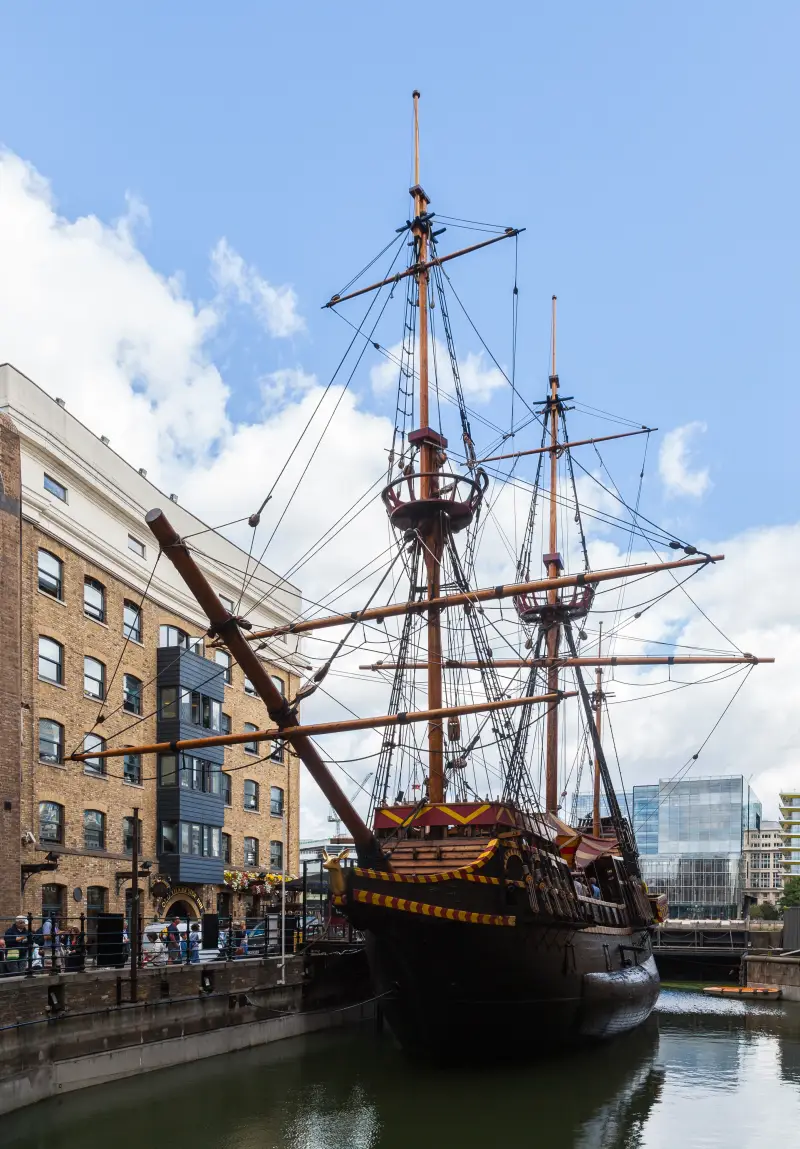Francis Drake - pirate admiral

The Drake Passage is the most dangerous and widest strait in the world. Passing through it on a sailing ship is akin to climbing Everest. It was the English navigator, explorer, slave trader and pirate Francis Drake who became the first person to sail through the strait. And he became the first captain to circumnavigate the world.
early years
The exact date of birth of Francis Drake is unknown. He was born around 1540 in Tavistock, Devon. He had 11 younger brothers. When Drake was 8 years old, his family moved from the west of England to the east - to Kent. According to one version, Francis’s father was a staunch Protestant, so he could not take root in Devon. According to another - and it seems to me more likely - he was closely connected with the family of the corsair Hawkins, he himself made money by theft and piracy.
Be that as it may, Drake's father in Kent received the rank of deacon, and the boy at the age of 12 became an apprentice on a sailing merchant ship. Francis was distinguished by his diligence and flexibility of mind, he grasped everything on the fly. Therefore, the captain of a merchant ship, who had no children, left his ship to him as an inheritance. The captain dies, and at the age of 18 Drake becomes the captain of a small ship and begins sailing through the ports of France and England.
Piracy and circumnavigation
At a young age, Drake met the pirate John Hawkins, whose family his father was friends with. With this acquaintance began the career of the corsair Francis Drake. They plundered the Portuguese colonies on the west coast of Africa, taking slaves and booty. Then they took slaves to South and North America, where they exchanged them for gold. He was taken to England. This is a barter voyage.
In 1568 for a small flotilla Hawkins and Drake were attacked by the Spaniards, defeated, and the captains miraculously managed to survive. From that moment, Francis developed a grudge against Spain, and he devoted the rest of his life to revenge. After 4 years, Drake's expedition reached the shores of Panama, where he did not profit much. But in 1573 he plundered more than 20 tons of gold and silver. Realizing that he couldn’t take everything away, Drake had to bury most of the loot. This interested many adventurers, but no one officially found this money.
A couple of years later Francis became famous for the Rathlin Island massacre. The Irish who lived there resisted English colonization. The British killed more than 600 Irish and Scots, including about 400 civilians.
Trip around the world
I note that Queen Elizabeth knew about Drake’s robberies. And she sponsored him. The Queen issued the captain a letter of marque - permission to attack and capture a merchant ship of another country. Such raids infuriated the Spaniards. They knew about the involvement of the English crown in this, but they could not influence Elizabeth in any way. She did not officially give permission and did not sign decrees.
At the beginning of 1578, Drake took 6 ships and set off along a well-trodden route - from Plymouth to the west coast of Africa. Having “stealed” slaves from there, he sailed across the Atlantic Ocean to South America. But Drake had to abandon two ships, because the crew fell ill with fever, the mortality rate was high, and all the sailors already fit on four. In Argentina, Drake executed his close friend and assistant Thomas Doughty for treason, who, according to one version, offered to turn around and return to England.
In the 16th century, people already knew that the Earth was round. And even Magellan's team made the first circumnavigation of the world. True, without the captain himself, who died on the way. His ships sailed under South America through the strait that took his name. People at that time were sure that there was nothing below, and this was the only way from the Atlantic to the Pacific Ocean. They didn’t know about Antarctica at that time.
Plundering Spanish and Portuguese cities, Drake's fleet approached the Strait of Magellan. It was July 1578. In 16 days, Drake crossed the Strait of Magellan on one ship. Another drowned, the rest returned to England for various reasons. On a single ship, the Golden Hind, Francis discovered an island, which he named Elizabeth, in honor of the current Queen of England.
According to the widespread version, Drake reached Cape Horn and passed through the strait, which was later named in his honor. But, according to the team members, they did not see the open sea, their descriptions did not coincide with the descriptions of Cape Horn and the Drake Passage. But, be that as it may, it is believed that it was Francis who became the first captain to sail there.

Engraved map of the world showing Drake's route
Before Drake, no one thought that you could just sail into the bay and kill the entire fleet and plunder the port. No one acted so brazenly and openly. And on the west coast of South America, no one expected that one ship would sail into the port and completely plunder it. Drake robbed Spanish trading ships and settlements. There was a lot of loot.
The "Golden Hind" rose higher to North America, where it reached 48° north latitude - where Vancouver, Canada is now located. He also hoped to find another passage to the Atlantic. Due to the harsh climate, Drake descended lower - to the place where San Francisco is now located. Drake founded the country of New Albion in this place and proclaimed himself the governor of these lands.
In the summer of 1579, Drake's only ship set off for the Pacific Ocean, which he crossed in a couple of months. In the Philippines he stocked up on provisions, reached Java, and crossed the Indian Ocean. Having reached the Cape of Good Hope, the southernmost point of Africa, he walked along the western coast of the continent. The Golden Hind returned to the Atlantic 2 years later.
On September 26, 1580, Drake, who was already considered dead, sailed to Plymouth on a ship full of treasure. They provided him with a comfortable future, and the queen made him a knight. A year later, Drake became mayor of Plymouth, and in 1585 - commander of a fleet of 25 ships.

Copy of The Golden Hind in London
Naval battles with the Spanish fleet
In 1586, the Spaniards began preparing a fleet to attack England. There were several reasons for this:
• Spain saw England's growing influence in the world and did not want to give up its leading position.
• Spain sought revenge on England for its approval of the raids of Drake, who plundered several major Spanish ports with his new fleet in 1585.
• Help the Pope return the British to the fold of Catholicism.
Elizabeth Tudor supplied Francis Drake with a fleet of 30 ships and sent him to the shores of Spain in order to weaken its power. Drake destroyed Cadiz in 36 hours, destroying dozens of ships and ammunition depots. This did not stop the Spaniards, but delayed their attack by a whole year.
In the summer of 1588, the great Spanish Armada approached the English shores. On the English side, the fleet was commanded by Admiral Lord Howard, and Drake was his vice-admiral. According to one version, Francis did not play a significant role in this great battle. He just kept the Spanish galleon after the battle.
There is a legend among the English that Drake was playing bowls when the first enemy ship appeared. And the captain said: “There is still time to finish the game and defeat the Spaniards.” As a result, the ships of Spain were forced to go around all the British islands in order to return back, because the path through the English Channel was closed to them. The ships were stretched thin, many unable to withstand the harsh climate in northern Britain. The formidable Spanish Armada lost half of its fleet as a result of this campaign - about 60 out of 120. And only about 10 were destroyed by the British.
last years of life
The last few years of Drake's life cannot be called successful. The expedition to Portugal did not bring any benefit; raids on Spanish colonies and attacks on their ships were also unsuccessful. Drake's small fleet was defeated in a battle in San Juan, Puerto Rico, off the coast of Panama.
Francis's team was beset by nothing but troubles - from defeats in battles to fever. She mowed down a significant part of his fleet, and even reached the captain himself. The flotilla was located near Puerto Bello, present-day Portobelo, waiting out bad weather. And Drake himself, like part of his team, contracted dysentery. He died from it on January 28, 1596.
Francis' reputation is ambiguous. Other English captains did not like him because of his unreliability and self-interest. The Spaniards, whom he captured and robbed, spoke of him as a noble villain. According to them, he always behaved politely towards his prisoners.
I would like to end the article with the words of Drake’s contemporary, Elizabethan historian John Stow:
Information